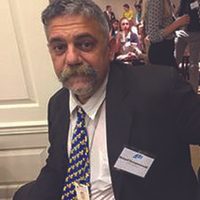With Scripture readings, prayers, hymns and a procession, about 70 people gathered at dusk on Nov. 2 – All Souls Day – at Sacred Heart Parish in Bowie, Maryland to commemorate, honor and remember the dead buried in the parish graveyard.
“We gather here today to pray for our brothers and sisters, known and unknown, whose bodies lie here in rest,” said Father Michael Russo, administrator of the parish. “We pray that God may welcome them among all the saints of heaven.”
Held on an unseasonably warm November evening, the graveyard vigil included a short prayer service, a chanting of the Litany of the Faithful Departed, a procession through the cemetery and the placing of blessed candles on the graves.
Father Russo reminded those gathered at the cemetery, that the graveyard vigil “celebrates the reality that even after death, we are part of the Church.”
In praying for those buried in the cemetery, Father Russo asked God to “look kindly upon your servants, now freed from the bond of mortality, and count them among your saints in heaven.”
Several years ago, Sacred Heart Parish found through ground penetrating radar that there appear to be hundreds of unmarked and unidentified graves and burial sites throughout its 33-acre property.
Previously, the property was on one of the plantations owned by members of the Society of Jesus, the Jesuits, in Maryland in the 1700s and 1800s, and enslaved people who worked at that plantation may be buried in the unmarked graves there.
Some of those buried in the graveyard may be related to the
272 enslaved men, women and children the Maryland Society of Jesus sold in 1838 to Louisiana plantation owners which helped ensure the financial survival of Georgetown College, which is now Georgetown University.


Father Russo called the discovery of the graves the start of a “providential journey.” It has been estimated that perhaps 600 or more unmarked graves of enslaved people may be located in the heavily wooded and overgrown hillside not far from the original parish church.
“Even in burial there was inequity here,” Father Russo lamented. “What we are doing here tonight is serving God and making sure we honor all those buried here.”
In processing through the graveyard, Father Russo prayed that God would have mercy “on those of whom no special remembrance is made on earth.”
Among those participating in the candle lighting ceremony was Irving Gaither, whose genealogical research led him to discover that five of his enslaved ancestors were born at the site and at least two or three died on the property that is now Sacred Heart Church.
“Working on my genealogy, I discovered that all four of my grandparents are connected to this property – everyone in my family has someone buried on this hill,” Gaither said. “I am not Catholic, but I am here because it is important for me to learn about my ancestors’ traditions. It is a way to honor them.”
Volunteers from the parish, universities and others have been active in clearing the overgrown areas of the cemetery so that archaeologists can identify and map additional possible burial sites. To that end, the parish has even employed goats to graze on the land to efficiently eat poison ivy and other invasive plants. The next cemetery clean-up day will be on Saturday Nov. 9 from 10 a.m. to 3 p.m.
















